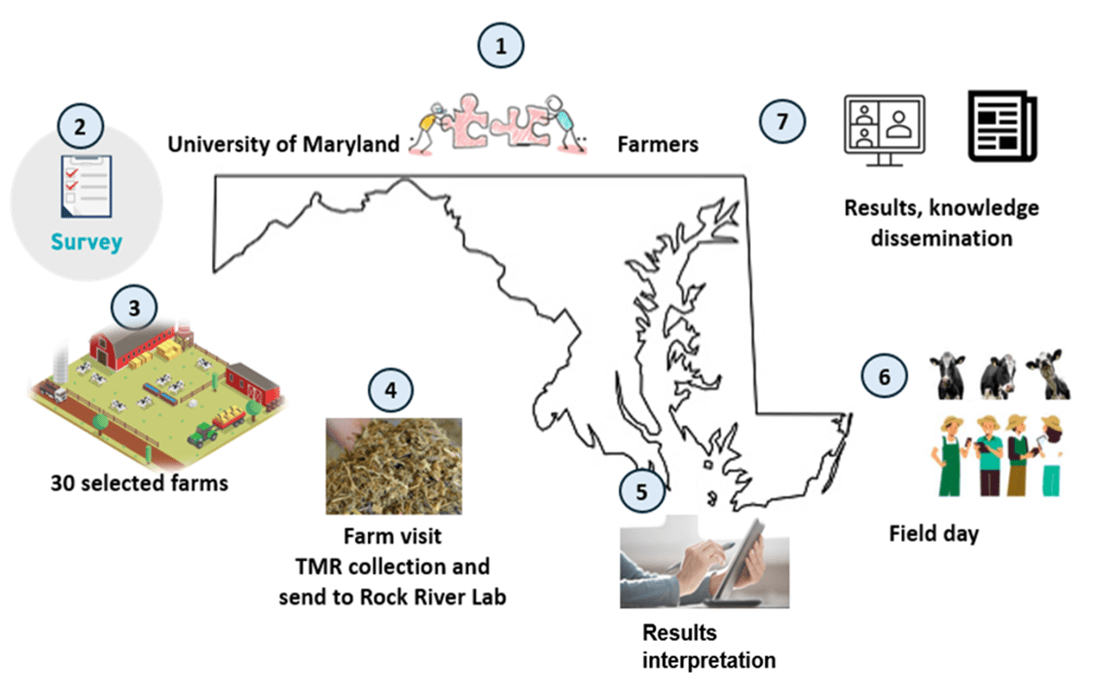Microorganisms in Feed on Maryland Dairy Farms

Another project currently being conducted is an extension based project involving analyzing Maryland dairy farmer’s knowledge of feed contamination from mycotoxins and clostridium, testing their feed, and afterwards supplying them with educational materials to improve their feed management.
A survey was sent to 293 dairy farms across the state to assess their knowledge, concerns and experiences with mycotoxins and clostridium contaminating their corn silage and total mixed ration (TMR). As of July 30, 53 farms have responded. We have just sent out a follow up letter to encourage more responses.
The survey inquired on things such as the size and production of each farm, and details such as breeds of cow and feedstuffs that are used. The farmers were then asked about their corn silage and TMR management, knowledge of contamination, and experiences with mycotoxins and clostridium. It is worth noting that a some dairy farms in Maryland are grassfed operations so the survey did not apply to them. Farmers were also asked general questions such as if they needed help with anything else, if the survey was helpful, and if they are interested in educational resources.
In the next step we will be visiting dairy farms that are willing to have us to sample their feed and test for mycotoxins and clostridium. We can use this data to better understand the prevalence of mycotoxins and clostridium in Maryland corn silage and TMR. Afterwards, we will come back to the farms with educational materials to reduce their feed contamination. These educational materials will be free of charge and offered in several different formats to allow farmers with different media capabilities and preferences to understand the material. Finally, a field day will be conducted to provide a group learning setting.
This article appears on September 2024, in Volume 5, Issue 2, of the Maryland Milk Moos newsletter.
 English
English العربية
العربية Български
Български 简体中文
简体中文 繁體中文
繁體中文 Hrvatski
Hrvatski Čeština
Čeština Dansk
Dansk Nederlands
Nederlands Suomi
Suomi Français
Français Deutsch
Deutsch Ελληνικά
Ελληνικά हिन्दी
हिन्दी Italiano
Italiano 日本語
日本語 한국어
한국어 Norsk bokmål
Norsk bokmål Polski
Polski Português
Português Română
Română Русский
Русский Español
Español Svenska
Svenska Català
Català Filipino
Filipino עִבְרִית
עִבְרִית Bahasa Indonesia
Bahasa Indonesia Latviešu valoda
Latviešu valoda Lietuvių kalba
Lietuvių kalba Српски језик
Српски језик Slovenčina
Slovenčina Slovenščina
Slovenščina Українська
Українська Tiếng Việt
Tiếng Việt Shqip
Shqip Eesti
Eesti Galego
Galego Magyar
Magyar Maltese
Maltese ไทย
ไทย Türkçe
Türkçe فارسی
فارسی Afrikaans
Afrikaans Bahasa Melayu
Bahasa Melayu Kiswahili
Kiswahili Gaeilge
Gaeilge Cymraeg
Cymraeg Беларуская мова
Беларуская мова Íslenska
Íslenska Македонски јазик
Македонски јазик יידיש
יידיש Հայերեն
Հայերեն Azərbaycan dili
Azərbaycan dili Euskara
Euskara ქართული
ქართული Kreyol ayisyen
Kreyol ayisyen اردو
اردو বাংলা
বাংলা Bosanski
Bosanski Cebuano
Cebuano Esperanto
Esperanto ગુજરાતી
ગુજરાતી Harshen Hausa
Harshen Hausa Hmong
Hmong Igbo
Igbo Basa Jawa
Basa Jawa ಕನ್ನಡ
ಕನ್ನಡ ភាសាខ្មែរ
ភាសាខ្មែរ ພາສາລາວ
ພາສາລາວ Latin
Latin Te Reo Māori
Te Reo Māori मराठी
मराठी Монгол
Монгол नेपाली
नेपाली ਪੰਜਾਬੀ
ਪੰਜਾਬੀ Afsoomaali
Afsoomaali தமிழ்
தமிழ் తెలుగు
తెలుగు Yorùbá
Yorùbá Zulu
Zulu ဗမာစာ
ဗမာစာ Chichewa
Chichewa Қазақ тілі
Қазақ тілі Malagasy
Malagasy മലയാളം
മലയാളം සිංහල
සිංහල Sesotho
Sesotho Basa Sunda
Basa Sunda Тоҷикӣ
Тоҷикӣ O‘zbekcha
O‘zbekcha አማርኛ
አማርኛ Corsu
Corsu Ōlelo Hawaiʻi
Ōlelo Hawaiʻi كوردی
كوردی Кыргызча
Кыргызча Lëtzebuergesch
Lëtzebuergesch پښتو
پښتو Samoan
Samoan Gàidhlig
Gàidhlig Shona
Shona سنڌي
سنڌي Frysk
Frysk isiXhosa
isiXhosa